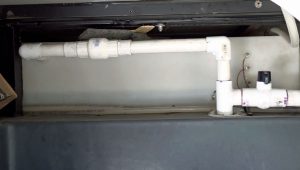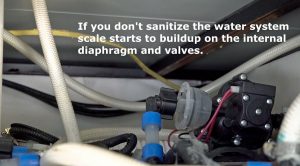Your RV is equipped with a 12-volt on-demand water pump. The pump is part of the essential equipment that makes your RV self-contained. If you aren’t connected to a city water supply, you can store potable water in the RV’s freshwater tank. And when you need water, you simply turn the water pump switch on.
 When the water pump is turned on, it pressurizes the entire water system and shuts off at a factory set shut-off pressure. When you open a water faucet in the RV, the water pressure starts to drop. When it reaches a preset pressure, a switch closes, turning the pump back on, and it pressurizes the water system again.
When the water pump is turned on, it pressurizes the entire water system and shuts off at a factory set shut-off pressure. When you open a water faucet in the RV, the water pressure starts to drop. When it reaches a preset pressure, a switch closes, turning the pump back on, and it pressurizes the water system again.
That’s a quick rundown on how your RV water pump works. Now, we can discuss some easy preventive maintenance steps to keep the pump working. RV water pump preventive maintenance is simple. It primarily consists of keeping the water system sanitized, and periodically inspecting and cleaning the strainer.
 Sureflo, a leading water pump manufacturer, stated that a lack of sanitizing the water system is the number one reason for premature pump failure and poor performance over time. When you don’t sanitize the RV water system, scale starts to build up on the internal diaphragm and valves. Eventually, this scale can cause low water flow and leak back. An indicator of leak back is when the water pump sporadically cycles on when no faucets in the RV are open.
Sureflo, a leading water pump manufacturer, stated that a lack of sanitizing the water system is the number one reason for premature pump failure and poor performance over time. When you don’t sanitize the RV water system, scale starts to build up on the internal diaphragm and valves. Eventually, this scale can cause low water flow and leak back. An indicator of leak back is when the water pump sporadically cycles on when no faucets in the RV are open.
I always sanitize the RV water system when I take the RV out of storage in the spring, and anytime we notice an odor in the plumbing system. I just mentioned that leak back can cause the water pump to cycle on when all the faucets are turned off. Another thing that will cause the pump to cycle on when the faucets are closed is a leak somewhere in the plumbing system. So, if your RV water pump starts cycling on and off when there’s no demand on the pump, turn it off and inspect the water system for leaks.
To clean the water pump strainer, make sure the water pump and any water supply going to the RV is turned off, and open a faucet in the RV to relieve the water pressure. Disconnect the water line going to the strainer on the front of the pump. Next, unscrew the strainer assembly from the pump. On most water pumps, you can simply grasp the front section of the strainer and turn it counterclockwise. It will separate from the main section of the strainer. Now, you can remove and clean the strainer screen. When the strainer is clean, reassemble it in the opposite order.
Make sure there is water in the freshwater holding tank, turn the pump on to pressurize the system, and check for leaks in the areas where you were working. So, routinely sanitizing the RV water system and periodically cleaning the strainer can extend the life of your RV water pump. Add these checks to your RV preventive maintenance schedule and it’s one less thing to be concerned about. To learn more about using and maintaining your RV, visit rvonlinetraining.com.
Happy camping
To learn more about how to use your RV,
Happy RV Learning,
Mark Polk, your trusted source for RV education


 When the water pump is turned on, it pressurizes the entire water system and shuts off at a factory set shut-off pressure. When you open a water faucet in the RV, the water pressure starts to drop. When it reaches a preset pressure, a switch closes, turning the pump back on, and it pressurizes the water system again.
When the water pump is turned on, it pressurizes the entire water system and shuts off at a factory set shut-off pressure. When you open a water faucet in the RV, the water pressure starts to drop. When it reaches a preset pressure, a switch closes, turning the pump back on, and it pressurizes the water system again. Sureflo, a leading water pump manufacturer, stated that a lack of sanitizing the water system is the number one reason for premature pump failure and poor performance over time. When you don’t sanitize the RV water system, scale starts to build up on the internal diaphragm and valves. Eventually, this scale can cause low water flow and leak back. An indicator of leak back is when the water pump sporadically cycles on when no faucets in the RV are open.
Sureflo, a leading water pump manufacturer, stated that a lack of sanitizing the water system is the number one reason for premature pump failure and poor performance over time. When you don’t sanitize the RV water system, scale starts to build up on the internal diaphragm and valves. Eventually, this scale can cause low water flow and leak back. An indicator of leak back is when the water pump sporadically cycles on when no faucets in the RV are open.